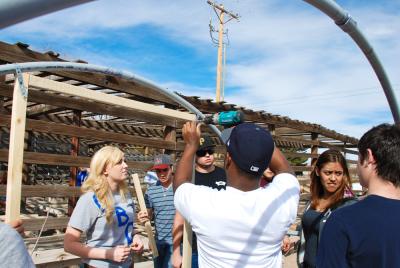NMSU students build, use, evaluate hoop houses in plant science class

Lab sessions during the week of Feb. 4 took place at the university's Fabian Garcia Science Center near campus, where students built five small hoop houses to be used in conjunction with class activities this semester and in the future.
Hoop houses, also known as passive-solar high tunnels, are an increasingly popular approach for small producers to extend their growing season. They are similar to regular greenhouses, but are made from less expensive materials and are intended to be less permanent.
Twenty-some students were on site for the early Wednesday afternoon lab session, digging the perimeter trenches, pounding lengths of re-bar into the soil, cutting plastic electrical conduit for the hoops and braces, framing the door opening, connecting all the pieces with metal straps and screws, and, finally, stretching the sheet plastic and securing it in place.
John Mexal, a Distinguished Achievement Professor in the Department of Plant and Environmental Sciences, is teaching the course this semester and was on hand with his teaching assistants and several faculty colleagues to keep things moving. The students raised hoop house number three in about 90 minutes.
For Mexal, this was deja vu all over again. He taught the class in fall 2006, when students built the previous set of three hoop houses in the same location.
"We thought it would be good to actually demonstrate the capacity of these types of structures to students who may have an interest in their own food production," Mexal said. "We not only built the houses, but then every year we've had the students grow a crop, both for the fall semester going into the winter and then winter going into the spring. They get to see the benefit of protected structures on soil temperature, growing environment, and just see how these types of protected environments can be used by horticulturists."
He sees the hoop house component of the course as very relevant in the context of the expansion of what he calls "peri-urban" agriculture, which includes small producers supplying food to local farmers markets and restaurants.
The previous set of hoop houses at the science center were all made with PVC plumbing pipe. Mexal says they lasted well, but this time around the department will be able to compare, in hoop houses built side-by-side, the long-term photo-resistance of the gray electrical conduit with that of the more traditional PVC "schedule 40" pipe.
For the current class, hoop house construction will soon be followed by planting, with small groups of students planting a combination of root crops, such as carrots and radishes, along with a selection of leafy greens.
"Each group will have roughly a three-foot by four-foot section in the hoop house where they can actually grow their own crop," Mexal said.
These students will also be involved in a comparison between the transparent sheet plastic covering such as was used last time and the opaque white plastic being incorporated in house number three. Mexal said the former allows about 90 percent of the sunlight through while the latter only allows 55 percent to pass through.
In lab sessions late in the semester, the students will compare plant growth and performance of their crops in houses with the two different "skins," evaluating the effectiveness of each in the Southern New Mexico climate. Data from sensors in each house will give them round-the-clock information about air and soil temperatures, light intensity and moisture.
"Basically we have room for 30 mini-experiments," Mexal said.
Pedagogically, this class is run according to principles of experiential learning, which involves students getting hands-on experience with the subject matter.
However, experiential learning is much more than merely adding hands-on activities to lectures and reading.
Kulbhushan Grover is an assistant professor of sustainable crop production and a department colleague of Mexal's who has also taught this class in recent years. In fall 2012 he taught an advanced undergraduate principles of crop production class, also using experiential learning. He has given presentations at NMSU and at conferences about the application of this approach with agriculture classes.
"It's a four-step cycle," Grover said. "The first step is the students trying something hands-on, and then they take measurements, make observations, and they interpret some things from those observations and then synthesize that information, and then reflect back on what they learned through that experience, what went wrong and what would they change next time."
Concrete experience leads to reflective observation, which is followed by abstract conceptualization, leading to active experimentation - the incorporation of the new information using problem-solving and decision-making skills - as the learner engages in later concrete experience.
Important for the continual refinement of this course, experiential learning includes assessment of the impact on the student and how well it is enhancing students' understanding of the concepts. In this class, which has been taught every semester since the first hoop house set was built, that means a lot of information for the faculty members teaching the class to build on. In addition to Mexal and Grover, PES colleagues Mark Uchanski and Ryan Goss periodically teach the course.
"I am excited that our faculty and students are doing the hoop house project," said Richard Pratt, PES department head. "It is another example of the experiential learning approach that we are trying to advance at the new Student Centered Field Lab as well.
"We plan to continue expanding and upgrading our ability to foster these types of learning activities. Our students find them engaging and are always asking for more."


